| Pages:
1
2 |
semiconductive
Hazard to Others
  
Posts: 287
Registered: 12-2-2017
Location: Scappoose Oregon, USA.
Member Is Offline
Mood: Explorative
|
|
Electroplating of Nickel, waterless / organic solvent / possibly ionic liquids.
I've been experimenting for around two years with electroplating of metals in orgainc liquids. I've had partial successf in saturated carboxylic
acids and alcohols. My chemistry background is weak; just undergrad courses have been taken.
Recently, I decided to try an easier metal, Nickel; which in water can be plated with just table salt and distilled vinegar. Even severe overvoltage
(12+ volts) doesn't stop it from plating; although there is continual hydrogen bubble production during plating which I don't want for my final
process. (Hence the reason I'm trying to move to polarized organic liquids where the hydrogen is weakly ionizable). My goal was to verify that using
organic liquids without water didn't in some way affect even nickel, and interfere with plating.
My first two tests failed, which is surprising to me.
I've tried electroplating in pure glacial acetic acid 2cc's. Since this is not conductive by itself, I added a drop of formic acid to cause acid ions
to form. I also (later) tried a drop of menthol crystals, dissoved by heat, since this is able to plate sodium non-electrolytically, via Magnesium
metastasis; I thought Menthol might be less reactive than formic acid.
This solution ought not be sensitive to moisture because Nickel plates even in water, fine.
But, I ended up with precipitation and no deposit. Even putting it under inert gas, or under kerosine to block of oxygen access, made no difference.
On my second test runs, I switched to a weaker acid, propionic as the main carrier, and then added a drop of acetic acid -- which is the normal acid
that works in water. I'm counting on the very low ionizability of propionic acid to act as a substitute for water. There is only a tiny amount of
acetic acid in the solution. Ions go into solution, very well. It forms the same characteristic (?ligand?) color of nickel in water, Green. The
conductivity of pure propionic acid (by itself) is sub 1 miliamp, before introduction of acetate; even with 100V applied at less than 4mm separation.
The propionic solution is not acidic/ionized enough to clean tarnished nickel off if dipped in it, cold.
So if it is ethching, I surmise the rate is less than a micron per day. eg: I think this is not be able to clean off deposits from the (-) cathode.
Since even the (+) anode remains tarnished for over 24 hours. Even after adding a small amount of impurity, Acetate, or salt, the solution becomes
conductive. Again, the solution does not etch of the tarnish from the (+) anode, but only dissolves where the metal is clean. The tarnish is formed
by just placing it in formic acid, and applying a high voltage burst before drying it and placing in the test tube. Its' formic acid leavings, and
it *WILL* etch off in water/acetic acid.
After 24 hours of running it in glacial acids (2 cc's is very small sample), the color is far darker green than I have ever obtained in water, it's
well distributed, but it's not plating.
After centerfuging, the solution is clear, and conductivity remains the same. (Picture not shown). So, the colloidal haze seen in the following
picture is not the main mechanism of conduction, but dissolved nickel is the main mechanism.
The following picture is after 24 hours, and is a microscope zoom. The test tube is 12mm on the inside. The graphite electrodes (-), are a high
current and low current pair, in order to check if current density is the issue; Neither of them shows nickel plating even after running for an
additional 24 hours.
I have heard of Kolbe reactions, and realize that it might be causing fatty acids or carboxylic acids to decompose at the (+) supply anode. But, I
wouldn't expect that to stop a reaction from occurring at the (-) supply.
I would love to hear any ideas of why this isn't working. I've had luck with zinc, iron, and minor luck with aluminum and titanium (0.001 inch thick,
max).
But I'm stumped as to what it is that is affecting the cathode in these solutions that limits the thickness of metal that can be plated.
I'm using pulsed D.C. 60Hz, resistor limited, with 15mA forward currents and 1mA reverse currents for cleaning; and then I stop reverse currents to
check if it might be etching the nickel off. Doesn't seem to matter.
I can add boric acid, benzoic acid, lithium carbonate, or potassium hydroxide (and a dozen other impurities), to increase conductivity to any desired
level. But none of these make a difference either. (Note: I don't think table salt will dissolve in glacial carboxylic acids; so I didn't try it;
But, I didn't think the particular salt to increase conductivity in the analogous water processes mattered ... does it? )
What types of chemical side reactions would you expect to happen when attempting to plate in glacial acetic acid, or glacial propionic acid?
Thanks. (Stumped.)
(Btw: My experiment count is up to 487 over the last two years, I AM determined to figure this out.  ) )
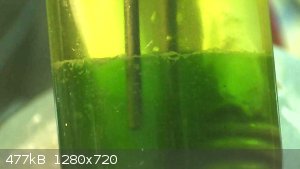
[Edited on 19-11-2023 by semiconductive]
|
|
|
Johanson
Harmless

Posts: 39
Registered: 23-3-2023
Member Is Offline
|
|
No one has commented yet, so I'll give it a go....
Your persistence is impressive (400 attempts?!) but your narrative is a bit confusing. What is your anode material? Are you simply placing a Ni anode
and a graphite cathode in an acetic acid plating bath, and applying 12V? It's not quite clear what your bath chemistry is, and what your anode is...
Acetic acid will tarnish nickel plated objects. That's why you don't use nickel-plated forks and spoons - they tarnish.
Overall, nickel plating is complicated. You chose the 'hardest one' to play around with. Maintaining a proper nickel plating solution is complicated.
Cleanliness of the bath is always a headache. So is the pH. Getting proper adherence of the nickel is also a pain in the butt - many things can
interfere with a solid, smooth nickel surface. Nickel plating starts with a "strike" phase at higher voltage, and then backs off for the main phase.
You are messing around with literally the hardest, most complicated plating process. Zinc plating is much, much easier.
You stated that your goal is to minimize hydrogen gas at the cathode? You do that through voltage control and pH control of the bath.
Just my initial impression.... but don't give up! 
[Edited on 21-11-2023 by Johanson]
|
|
|
semiconductive
Hazard to Others
  
Posts: 287
Registered: 12-2-2017
Location: Scappoose Oregon, USA.
Member Is Offline
Mood: Explorative
|
|
All comments, welcome; Thanks!
Anode material, pure nickel wire, 0.9mm diameter, spooled around 6 loops to give a total of 4 inches of length in a compact form that fits in a
test-tube. Visible in the lower left of the above picture.
Cathode materal, graphite sticks. Pentel high-polymer. 0.9mm diameter, ~4 inches long. Only 2CC's of acidic liquid in tube, roughly 2cm tall.
So, cathode area = 0.9mm * 2pi * 20mm = [ 113 mm^2 ] , .0113 [ Dm^2 ]
Current using magnetic clamp on source is adjusted during various tries from 15 [mA] to 33 [mA] (max); Which means, the current density is between
1.3 and 2.6 Amperes/Decimeter (average) on the high current graphite cathode (plating target the center/back graphite electrode in picutre).
The low current graphite cathode has same dimensions, but is current limited to about 10x less current. So, between .13 and .26 Amps/decimeter max.
| Quote: |
Are you simply placing a Ni anode and a graphite cathode in an acetic acid plating bath,
|
Two graphite cathodes, but yes.
That is one way the experiment is run, but it fails miserably.
There's precipitate when acetic acid is used by itself.
Salts don't like to dissolve into pure acetate, and running electricity through it results in more precipitation from + nickel anode.
That's why I switched (eg: see the above picture) to 2CC's of 99.9% Propionic Acid (Reagant Grade). To that chemical, I added a single drop of acetic
acid; I think a single drop is around 6 [uL] of liquid, typically. But I can't verify how precise that is.
I then ran the same experiment twelve different times (in different tubes) using various salts to see if any of them would trigger plating.
The most interesting combination was boric acid + lithium carbonate. That's what the above picture shows. That combination is under kerosine to keep
oxygen out. Later I added Butyl Butyrate, to see if I could increase solubility (not shown in picutre) and the answer is yes; but with some drawbacks
that aren't worth discussing here.
The voltage is pulsed D.C.; 120V half cycle into a limiting light bulb and series resistor, (rheostat), to I can adjust from 15mA to 50mA of foward
current average. The numbers I gave above have a peak current that is about 2.818 times larger than what I wrote down. The actual voltage on the
nickel is going to vary from 0V through 12V, or possibly 24V, depending on the solutions conductivity.
In response to your other comment:
Yes, acetic acid but with moisture from air will tarnish nickel.
OTOH:
Glacial acetic acid is acid with no water content, and it doesn't even conduct electricity; let alone tarnish nickel. Glacial acetic acid very
slowly (or not at all) etches clean nickel.
The addition of other acids or salts, is required for acid acticity; and I observe that several added salts or acids increase the etch rate.
But for the duration of these experiments, the control test tube with no electricity running in it, did not tarnish further nor did the initial
tarnish I put on it myself (as a control test), did not clean off. Eg: the coil is half tarnished (manually) before use, so I can compare what
happens to the nickel in either state.
Also, Note: (Very counter-intuitive) Lithium carbonate is only mildly soluble in pure propionic acid, and after this very slight amount of lithium
enters solution the remaining cold carbonate does not fizz.
On the other hand; Lithium carbonate is attacked by glacial acetic acid, cold. Which means the amount of LiCo3 that can be added to the test tube
before it begins building up at the bottom of the tube as powder ... is only about 1 drop's worth of volume. Eg: It mostly neutralizes the acetic
acid in the tube, which is then soluble in the propionic acid just fine; but doesn't neutralize the propionic acid.
I *think* this means that I have Lithium Acetate ionized in propionic acid, but the propionic acid is mostly non-ionized and travelling around the
test tube as dimmer molecules.
| Quote: | | You are messing around with literally the hardest, most complicated plating process. Zinc plating is much, much easier. |
In water, I find nickel extremely easy to get a result. Even if the result is dirty, it still plates. My experience is *exactly* like this:
https://www.youtube.com/watch?app=desktop&v=ii9I7ZatgJQ
Copper generally will not do this; but rather produces a black sludge in overcurrent situations, etc.
It took me two years to figure out how to get copper to plate at 1mm thickness/minute (electroforming rate) while maintaining shiny surface and dense
material.
Just using "copper sulfate" can't do that.
Titanium and Aluminum are the most difficult metals I've tried to get to plate (!! at all !!). Iron is the next most difficult.
Nickel isn't that bad; comparitively.
In several of the baths I've tried, I can get *all* out gassing to happen at the metal anode; no hydrogen released at the cathode at all. It has
nothing to do with the voltages in many of the experiments I've tried.
I think what you are talking about is probably more correct in water.
Re-reading what you've said, focus on this idea:
Right now, all I'm interested in is the "strike" phase of the plating.
The fact that I can't even get a strike is what's surprising me.
I can get zinc to plate in several solutions. Mostly, though, it likes a halogen such as Iodiine or Chlorine to be present. In organics (no water),
I haven't been able to get it to plate from alkalai type solutions.
|
|
|
semiconductive
Hazard to Others
  
Posts: 287
Registered: 12-2-2017
Location: Scappoose Oregon, USA.
Member Is Offline
Mood: Explorative
|
|
Today's experiment, #490
I've got some plating activity on the higher current electrode.
Not sure if it's metal or not.
I decided to try reducing the amount of acid available, and replace it with an alcohol.
14 drops acetic acid
7 drops sulfer-oxide bearing molecule (not acid / no hydrogen ).
14 drops iso-position alcohol
The polar sulfer-oxide molecule takes the place of salt; this generally tends to reduce bubbling at the cathodes, and biases acid attacks more toward
the anode.
This is the solution after 15minutes of plating at 10mA average current.
It's on about 7mm length of 0.9mm graphite.
I touched the graphite accidentally before putting it in, and I can see where my fingerprint was.
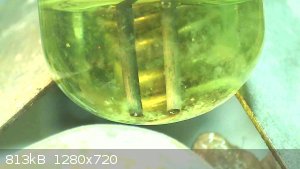
Only a very tiny bit of nickel shows up on the low current electrode.
I'm getting some floating solids, which is typical with acetic acid. I think the glacial acid has probably picked up some moisture from the air from
the number of times Ive opened the flask.
I'll centerfuge the tube ... and do some calculations to figure out what molecule percentage of reactions have taken place after letting this run for
12Hours.
|
|
|
semiconductive
Hazard to Others
  
Posts: 287
Registered: 12-2-2017
Location: Scappoose Oregon, USA.
Member Is Offline
Mood: Explorative
|
|
Unusually nice.
This morning, all solds were dissolved. Centerfuging, not needed.
From the dimensions of the test tube and what I estimate the height to be, a drop of fluid is closer to 16 [uL] or maybe even 20 [uL].
Acetic acid, glacial, is 17.5 Molar.
So, 17.5 [Mol/L] * 16 [uL] * 96320 [ Coulombs/Mole ] ~= 377 coulombs.
Acetic acid is only singly ionized.
Last night, the start current was at 10 [mA]. It's run 9 hours, and the current has dropped to 3.3 [mA].
Conservatively, then, 3.3 [mCoulomb/second] * 60 [seconds/minute] * [60 minutes/hour] * [9 hours] ~= 107 [ Coloumbs ].
If it was running at 10 [mA] most of the night, then ~= 325 [Coulombs]
I think this means between 1/3 and 8/10's of the acetic acid has been cycled.
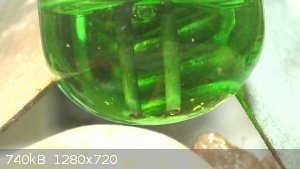
I don't see anything on the web, doing Google searches, for "Basic Nickel Acetate"; although the floating stuff I hypothesize probably is a half
hydroxide, half acetate, nickel material floating around in solution (and settling.)
But, I did find this paper:
https://www.researchgate.net/publication/338612394_Synthesis...
Which does suggest that it's possible to half-aceate - half hydroxide a nickel molecule. I doubt what I've got floating around in there is a
quadra-hydrate, because there simply isn't enough water to form that. All chemicals are 99.9+% pure.
I'll let the experiment run for another three days, and then consider how to repeat the experiment to learn something more using the Scientific
method. Hypothesis, welcome.... (anyone?)
[Edited on 23-11-2023 by semiconductive]
|
|
|
Johanson
Harmless

Posts: 39
Registered: 23-3-2023
Member Is Offline
|
|
Okay, your claim, "my chemistry background is weak" is obviously a bit exaggerated. Nice video BTW. I should have had you nickel plate my wife's
chrome bmw wheels, instead of having a local vendor here in L.A. do it - they wouldn't have flaked off so bad! I'm afraid your experiments above are
beyond my level of expertise. Someone with a lot of experience running Ni plating baths is going to have to help you sort through this 
|
|
|
semiconductive
Hazard to Others
  
Posts: 287
Registered: 12-2-2017
Location: Scappoose Oregon, USA.
Member Is Offline
Mood: Explorative
|
|
Um, if you mean my persistence, then I agree; but I really only have an undergraduate course in inorganic chem formally on my degree.
I am doing this the 'hard' way, because I don't know of *any* other way I can get it to work. Water might work for nickel, but it absolutely will not
work for sodium, potassium, titanium .... etc.
But: It's not like I'm hitting people up for cash. I'm just asking for ideas to try. Then I'll try them (if I have the chems/it's within reason);
and post results. After 490 tries, I don't have a lot of pride left in my ability to imagine reasons for why things are happening (or not.).
Even if your suggestion is 'bad'; I'm not going to sue you or anything.
I even tried nitric acid, which could be explosive with alcohols (eg: Nitro-Glycerine is one such example.) at the suggestion of someone a couple of
years ago. It did blow up every time it sparked or got hot, but ... oh well. Try again. ( I just use tiny amounts and a micro-centaur ceterfuge ).
Do you think I'd do better to switch to ZInc?
I could replace the anode with Zinc, if you think Zinc's easier.
But, I'm looking for reasons that you believe Zinc would be easier. What's different about it? There's still pH, adherence problems, etc., etc.,
etc.
I don't work with Chrome, as it's oxides are very dangerous. But, I do work with Iron Pyrite (Gold color), safe enough to do indoors. So, even
people who aren't "nickel" experts could still give me suggestions.
|
|
|
Rainwater
National Hazard
   
Posts: 800
Registered: 22-12-2021
Member Is Offline
Mood: indisposition to activity
|
|
This suggestion is expensive and dangerous, really leaning towards stupid.
High pressure can drastically change the solubility of ionic compounds.
One of the factorys I work with cleans aircraft parts in a water bath, under 30k psi. (15 tons)
Turns out grease will dissolve in water under this high pressure.
The water comes out discolored but a single phase and stays that way without treatment.
Perhaps the same principle could be applied to your problem.
"You can't do that" - challenge accepted
|
|
|
semiconductive
Hazard to Others
  
Posts: 287
Registered: 12-2-2017
Location: Scappoose Oregon, USA.
Member Is Offline
Mood: Explorative
|
|
Quote: Originally posted by Rainwater  | This suggestion is expensive and dangerous, really leaning towards stupid.
High pressure can drastically change the solubility of ionic compounds.
One of the factorys I work with cleans aircraft parts in a water bath, under 30k psi. (15 tons)
Turns out grease will dissolve in water under this high pressure.
The water comes out discolored but a single phase and stays that way without treatment.
Perhaps the same principle could be applied to your problem. |
It's something to think about. But I'm not sure how I could do it.
I have noticed that pressure, even small amounts, can change the solubility of things.
Note:
The last experiment dropped below 1[mA] so I pulled out the anode to check it, and sure enough it was coated with a green polymer. Most likely the
alcohol + acetic acid.
So, that version of the experiment is already finished/no good. There is metal or/metal hydroxide on the cathode, and it is adhered. But the
coating is so thin, that it's not representative of the average chemistry of the bath; it's basically a dud experiment.
On the other hand; I've found that oils and polars often do mix when as strong as I'm using. I have gotten oils with 20 [mA] currents due to
dissolved ions, easily.
I don't want to repeat failed stuff, so I'll try something new (random).
To demonstrate, I'm going to redo experiment #490 again.
The only variable I'm going to change is that I'll replace the alcohol with ether.
I think this will drop the ionic character of the liquid enough that oil will mix with it.
7 drops sulfur polar molecule
14 drops glacial acetic acid
24 drops ether
I would have (last year) expected this mixture to be totally polar and not mix with oil. In the last experiment, the kerosine, floated on top.
I'll now put silicone oil on top of this mixture; which is 'almost' as oily as kerosine.
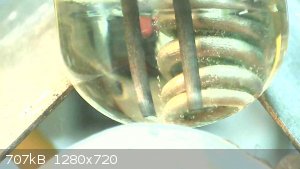
There is no oil above the liquid; the silicone went into solution and mixed with vinegar, ether, and polar sulfur-oxide bearing molecules.
Notice also:
You can clearly see the Nickel Anode bubbling; there are *no* bubbles forming on the graphite cathodes (-).
This is the kind of solution I was talking about that doesn't release hydrogen at the cathode. I can get solutions similar to this (but different
chemicals which I won't name) to plate Iron, Titanium, and aluminum, but only in thin layers.
I would think nickel or iron or zinc to be easier.
None the less: The solution always stops working after a few days.
In this new attempt:
The current, starts at only 1 [mA]. It's not very good.
eg: The resistivity is 10x higher than the previous solution using an iso-alcohol.
Since the voltages are 'high' 12-120V; that means there are 10x less ions present in this solution.
What advantage do you think pressure might bring to this type of experiment?
Is pressure likely to increase the number of ions? or only increase the probability that salt ions dissolve into solution?
Because if it's the latter (making oil and water/ions mix) I am clearly already doing it by just using glacial acetic or propanoic acids.
But if pressure can increase the number of ions present in solution, that would be interesting.
Just to follow up:
How thick is the 'bomb' that mixes water and oil at the company you work at?
Does 15Tons require wall thickness on the order an inch or so of steel?
I could imagine building something to put in a hydraulic press to manually squeeze small amounts of fluid to 15 Tons. But I'm not sure how I'd be
able to seal it.
I definitely wouldn't be able to put electrodes inside it while it was being pressed.
[Edited on 24-11-2023 by semiconductive]
|
|
|
semiconductive
Hazard to Others
  
Posts: 287
Registered: 12-2-2017
Location: Scappoose Oregon, USA.
Member Is Offline
Mood: Explorative
|
|
Note: From my transfer pipette, I counted the drops from the 1/2cc mark; and 24 drops of ether is 1/2cc.
So, my pipette is dispensing about 20.8 [uL] per drop.
[Edited on 24-11-2023 by semiconductive]
|
|
|
Johanson
Harmless

Posts: 39
Registered: 23-3-2023
Member Is Offline
|
|
I'm still following this b/c plating/electrochem fascinates me for some reason. HOWEVER, I'm still baffled by the direction you are going. Your STATED
GOAL in paragraph 2 of your original post was to develop a process that eliminated H2 gas as the cathode. That's what you stated. Why aren't you just
using an electroless nickel bath? It's none of my business, but it seems like you're spending a lot of time messing around with things that were tried
and discarded 150 years ago. Look at the old electroplating books from turn-of-the-century for example; they knew an awful lot about nickel plating,
and they dismiss acetate bath-chemistry as totally unhelpful. But I'm sure you know more about that than me after 2 years of playing around with it
 
If I had the time to mess around with nickel processes, I would be focusing on REMOVING nickel from various surfaces and RECOVERING it for reuse, not
plating it on surfaces. The area of battery recycling is going to be HUGE in the near future. Recovering metals from secondary batteries is almost
impossible from an economic-payback standpoint, and a breakthrough would pay off handsomely I would imagine. Anyway, keep going!
|
|
|
semiconductive
Hazard to Others
  
Posts: 287
Registered: 12-2-2017
Location: Scappoose Oregon, USA.
Member Is Offline
Mood: Explorative
|
|
| Quote: | | If I had the time to mess around with nickel processes, I would be focusing on REMOVING nickel from various surfaces and RECOVERING it for reuse, not
plating it on surfaces. The area of battery recycling is going to be HUGE in the near future. Recovering metals from secondary batteries is almost
impossible from an economic-payback standpoint, and a breakthrough would pay off handsomely I would imagine. Anyway, keep going!
|
Yes, being able to remove and recover nickel, lithium, and other metals efficiently is going to be huge. How many dead Toyota(Tm) Prius and other
Li-Ion batteries are in junk yards, is truly amazing. It's also a waste disposal problem.
I agree.
Note: Eliminating H2 Gas is from the cathode is part of the goal, not the whole goal. Since people believe nickel plating 'hard' to do; answers
found here are useful.
But, there are also other metals I'm interested in plating; Nickel is just an arbitrary choice to try out ideas on because I think it easier than
them.
Iron, for example, has a plating potential less than that of hydrogen; which usually means, hydrogen bubbles come out of solution at (-) cathodes
before Iron does. The same is true for Titanium and Aluminum. It's very difficult to get them to come out of solution because hydrogen (which is in
every acid) comes out first!
Electroless plating I would consider, if it could make thick (2mm - 10mm) pieces of Iron, Iron Pyrite, Zinc, Titianium, or Aluminum on top of a
graphite base, ( without releasing hydrogen bubbles ).
I'm only studying Nickel because it is easier than the above metals to get to plate out of solution. I'm studying electric processes because using
electricity is usually more cost effective than using large amounts of exhaustable chemicals that are difficult to re-process.
| Quote: | | but it seems like you're spending a lot of time messing around with things that were tried and discarded 150 years ago. |
Yes. I definitely am.
I have done as many searches as I can; and there is no way for me to determine what has and has not been done. Not every electroplating book is
online; and I don't have a huge amount of money to find all them. But I do have time. Lots of time. Hence, I do repeat experiments that have
supposedly failed.
Note:
There are a lot of lies out in the literature. People in industry sometimes want to keep the working methods to themselves by spreading
dis-information just like military counter-intelligence agencies. Even Patents in the United States are very commonly defective, when actually built.
It is not necessary for an idea to 'work' in order for it to be 'patented'; so it makes sense to patent a version of the idea that can work, but in a
way that doesn't directly work -- so your competitors can't use it without a lot of testing and effort. It's to prevent theft of intellecutal
property. Read the threads on Sodium production, on this site. They demonstrate how hard it was to reproduce the patent on Sodium production at
'low temperature', chemically, to the point where people began to believe the patent itself was phony. (It wasn't.)
Anything I discover here, in this thread, becomes public domain. Everyone wins (except future patent holders.) But for many amateurs, any discovery
would be a boon / advance of the general knowledge of chemistry.
[Edited on 24-11-2023 by semiconductive]
|
|
|
semiconductive
Hazard to Others
  
Posts: 287
Registered: 12-2-2017
Location: Scappoose Oregon, USA.
Member Is Offline
Mood: Explorative
|
|
Bubbling has accelerated, current remains at 1[mA]. Experiment #490, the "ether" variation.
Noticeable at the bottom is a white precipitate. There is also a whitish film on the nickel.
No plating is evident, just traces on the right (high current) cathode.
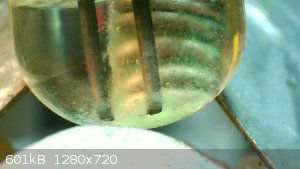
Since the color is not green, I don't think this is the same coordination complex as the last experiment had. There's only tiny amounts of green on
the nickel anode itself, which is consistent with traces of water from the air haven gotten into the glacial acetic acid.
Whether the white stuff is just anhydrous nickel acetate, or possibly nickel acetate adduct with either ether or a sulfuric oxide bearing molecule, is
unknown. But it's interesting.
Runing the experiment to exhaustion will give clues; I expect between 5 and 10 days according to the calculation I ran before. That's acceptable. I
will report back, in later posts, when I get all the data.
Edit: Current rose to 1.5 [mA] this afternoon; 16 hours in. After gently tapping the anode to dislodge the white film which fell to the bottom as
flakes; current rose to 2.0 [mA]. So, closer to 5 days. This is a slightly unusual change; most current increases happen within the first hour of
starting an experiment. It's atypical for current to rise *after* precipitation has begun.
Edit: Mixed up a second test tube just to check solubility without Ether.
7 drops sulfer based polar molecule
14 drops glacial acetic acid
21 drops silicone (Dimethicone) oil, cosmetic grade, 1Cst.
Initially there was no mixing of silicone at all. The acetic acid + sulfer polars sank to the bottom. Upon heating tube (gently) with a 25Watt
soldering iron, a substantial amount of silicone seemed to be absorbed by the polar mixture; maybe 1/3rd of it. 1/2 to 2/3rds of the silicone
remained floating on top.
Upon running electric current in the cell, I would predict the silicone to mix more.
Glacial acetic acid has a non-polar end and a polar end; once the polar end is bound up in nickel ... the other side is free to dissolve in oil. eg:
a bit like soap or detergent.
[Edited on 24-11-2023 by semiconductive]
|
|
|
Johanson
Harmless

Posts: 39
Registered: 23-3-2023
Member Is Offline
|
|
"Since people believe nickel plating 'hard' to do; answers found here are useful."
Well, I only mentioned that because at one point in my career I was working on recovering metals from plating waste, and the people running all the
nickel baths spent their time fixing seemingly never-ending problems. Work-piece cleanliness, work-piece positioning, bath contaminants... it never
seemed to end. Being in the business of plating commercial and military parts, and having them stand-up to long-term abuse is quite different than
doing lab-scale experiments. That's all I meant.
"Yes. I definitely am...."
Okay, thanks for clarifying. I'm not trying to be critical, I'm just testing.
"There are a lot of lies out in the literature."
Yes, bovine excrement is the term. Or, as we used to say, "marketing license".
Fe plating: There's lots of literature on this, from way-back. This wasn't the direction people wanted to go, obviously; they were interested in
plating things ONTO steel, not the other way around. But there's a lot of discussion going back to the beginnings of e-chem.
Sources: I find the old ones (1890s through 1930s, roughly speaking) to be helpful, because they give you all the bath chemistry. Granted, it is old
information, but it gives you a starting point. Modern literature - for example, "The Nickel Plating Handbook" (the Nickel Institute), doesn't give
much in the way of detailed chemistry. The bath solutions are proprietary, as you stated.
I'd be glad to dig up some text references (they're all free online) if you want, but you've probably moved beyond them already(?)
|
|
|
semiconductive
Hazard to Others
  
Posts: 287
Registered: 12-2-2017
Location: Scappoose Oregon, USA.
Member Is Offline
Mood: Explorative
|
|
I'm happy to read old sources from online. I can even run a few experiments in water. But, I don't think they are going to have a solution to my
issues.
But: Your links may be valuable to other readers, too.
----
The current in #490 ether variation, has risen to 3 [mA]. No point in running this longer since current is high enough. All the active chemicals
have had an opportunity to hit the anode at least once. The glacial acetic acid is not compeletely precipitated.
In spite of the small amount of silicone oil and it's hydrophobicity, the color green in the precipitate increased. Without speculating on it, here
a photo. The amount of precipitate is in the ballpark of 7 drops worth of liquid. That means about half the acetic acid, or all the sulfur compound
is on the bottom.
Liquid level has dropped, so a certain amount of the chemicals have been destroyed ( ?? Kolbe reaction, maybe ??) or evaporated.
I don't know why. I'd appreciate thoughts.
No obvious signs of plating.
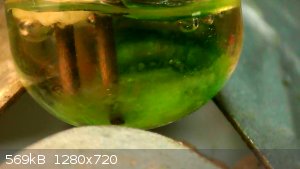
------
And just for completeness, I let the pure silicone oil tube I mixed up in the previous post -- sit for a few days and it became colloidal. Added a
couple drops of silicone oil and it immediately cleared up again but the separation became invisible. It *now* looks like the silicone totally
dissolves in the acetate+sulfur compounds.
I wonder what's up with that.
Here's a shot of how straight silicone oil on top of acetic + sulfur oxide, looks like.
Current flow is in the 100 micro-amp region,eg: not even one milliamp. But I can see the silicone oil around the anode flicker and flow due to ions
moving.
I'm re-using the anode after cleaning, which is why it's pitted.
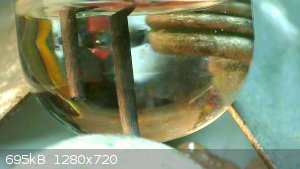
After fiddling around with the anode, I noticed there are no bubbles formed unless it is near the very bottom of the tube; and then only the bottom
part of the anode bubbles. I'm pretty sure this means that the sulfer dioxde bearing molecule must be denser and sinks to the bottom. Without
sulfur to affect it, acetic acid will not release hydrogen at the anode.
It's just not possible to see the liquid separation since the densities are so close and the refraction, too. Current rose to 500 micro-Amps with the
anode inserted fully. It's about half the current of the previous run, using ether, at the start.
[Edited on 26-11-2023 by semiconductive]
|
|
|
mysteriusbhoice
Hazard to Others
  
Posts: 477
Registered: 27-1-2016
Member Is Offline
Mood: Became chemistry catboy Vtuber Nyaa
|
|
why not use an actually conductive liquid like propylene carbonate or acetonitrile as your electrolyte.
|
|
|
semiconductive
Hazard to Others
  
Posts: 287
Registered: 12-2-2017
Location: Scappoose Oregon, USA.
Member Is Offline
Mood: Explorative
|
|
Hi, thanks for the suggestion.
I do have propylene carbonate reagent grade, (Southern tier scientic TM) and DMSO, among others.
I only have yellow prussate no ac-nitrile, eg: I have K Fe CN_x H2On crystals. Those are safe because the iron binds the cyanide. In weak acids
(eg: acetic), it can be used without release of gas.
What would you suggest trying?
Just using 21 drops PC and 7 of acetic?
Or add NaCl, CaCl2, SrCl2, or something?
I'm definitely happy to attempt propylene carbonate.
But also I'm very curious why I have current flow, yet no deposits in the last two experiments. After a certain point, I would think all the acid is
exhausted and combined with nickel; so, do you have any idea why electrical reduction continues to happen at the cathode ... but no material shows up
on it?
When starting in the silicone solution, I only had 500uA current; but 10 hours later, I had 1.8 [mA]. So, what-ever the reaction is ... it can change
conductivity.
The question will be the same if I use Propylene Carbonate, and it doesn't plate.
What 'side' reaction can go on nearly indefinitely, but deposit nothing?
Note:
#490 -- silicone + acetic + SO2 bearing molecule; after a full 24 hours.
Some precipitate visible, much less precipitate than last experiment;
low current cathode (-) on right shows some whitish deposit near the bottom, high current cathode (-) on left does not. Current is at 500 [ uA ];
eg: Current wen't back to what it was when starting. So under silicone there is a reaction that increases conductivity, but it's mostly used up
within 24 hours.
Another dud experiment. Oh well, try again. 
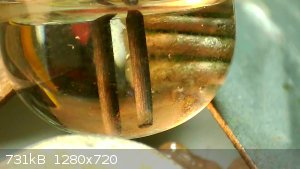
Let me know how you want propylene carbonate mixed, and I'll set up experiment #491.
[Edited on 27-11-2023 by semiconductive]
|
|
|
semiconductive
Hazard to Others
  
Posts: 287
Registered: 12-2-2017
Location: Scappoose Oregon, USA.
Member Is Offline
Mood: Explorative
|
|
I found this, which is a little more detailed than the wikipedia article.
Kolbe Reaction to make alkenes
The article indicates that an alkalai metal is used Na, or K, during a Kolbe decarboxylation reaction. It also indicates that hydrogen is released at
the cathode.
Similarly, for acetic acid, alkanes can form:
https://www.youtube.com/watch?v=be8D0kLeOSQ
There's no hydrogen being released at the cathode in my setup; and there's no alkalai metal in the mix; just nickel. It's not proof, that Kolbe
reaction isn't happening; but I don't have the normal conditions for it.
https://www.youtube.com/watch?v=-OpWbSun2d8
I added 14 drops of acetic to see if that was the limiting chemical in the reaction; no change, stayed in the microamp region. Warmed it, no change.
I could see the acetic acid mix into all the liquid, uniformly.
Therefore: I Added another 7 drops SO2 bearing molecule, and immediately bubbles form on the anode. I've got a full 3 milliamps of current flowing,
now.
There is also layer separation visible where the sulfur molecule has sunk; and bubbles only form below that line. I think this means that Acetic Acid
will misc with silicone oil; but a sulfur dioxide bearing material will be polar enough to sink (at first).
Also, the slight silvery color on the graphite electrodes remained when I added acetic acid; but etched off immediately upon adding the polar
molecule.
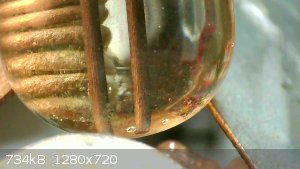
[Edited on 27-11-2023 by semiconductive]
|
|
|
semiconductive
Hazard to Others
  
Posts: 287
Registered: 12-2-2017
Location: Scappoose Oregon, USA.
Member Is Offline
Mood: Explorative
|
|
While I wait for a more specific suggestion ... I tried an ester + carboxylic acid, spiked with a tiny bit of lithium carbonate.
This fizzes, and of course hydrogen bubbles form at the cathode because as lithium plates out, it will attack even the ester and release hydrogen.
After running 12 hours, the current has dropped from 38 [mA] down to 5 [mA]. But it is now plating. This is very similar to what water will do.
Notice there is a thick plating of nickel on the high current electrode (-).
But, There is only black tarnish on the low current electrode (-).
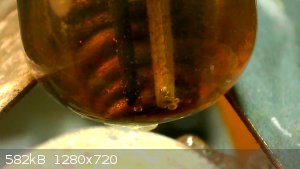
The metal is likely not adhered, well; which is fine for a first test.
[Edited on 28-11-2023 by semiconductive]
|
|
|
DraconicAcid
International Hazard
    
Posts: 4280
Registered: 1-2-2013
Location: The tiniest college campus ever....
Member Is Offline
Mood: Semi-victorious.
|
|
A choline chloride-based ionic liquid might be an interesting bath to plate from.
Please remember: "Filtrate" is not a verb.
Write up your lab reports the way your instructor wants them, not the way your ex-instructor wants them.
|
|
|
semiconductive
Hazard to Others
  
Posts: 287
Registered: 12-2-2017
Location: Scappoose Oregon, USA.
Member Is Offline
Mood: Explorative
|
|
I have choline chloride; I have urea, and I have thiourea.
I also have propylene-diol, and n-propanol; I sometime see those mentioned with choline.
Do you have any particular mixture / salt to suggest I try with choline chloride?
Or should I just use straight Choline Chloride, and heat it in order to melt it?
Thanks.
|
|
|
DraconicAcid
International Hazard
    
Posts: 4280
Registered: 1-2-2013
Location: The tiniest college campus ever....
Member Is Offline
Mood: Semi-victorious.
|
|
I'd do the choline chloride/urea mixture. I wouldn't trust the thiourea (or thio anything) not to give nasty insoluble sulphides.
Please remember: "Filtrate" is not a verb.
Write up your lab reports the way your instructor wants them, not the way your ex-instructor wants them.
|
|
|
semiconductive
Hazard to Others
  
Posts: 287
Registered: 12-2-2017
Location: Scappoose Oregon, USA.
Member Is Offline
Mood: Explorative
|
|
Expriment #491
Choline chloride: 136 [g/mol]
Urea 60.0 [g/mol]
Eutectic is 1:2 molar mixture. eg: 1.133 x the grams of Choline as Urea is eutectic.
Trying .500 [g] of ChCl 98%, .440 [g] of prilled urea.
Put under 1 [mL] of kerosene before melting, to keep moisture out.
Gently heat until melted, then allow to cool.
Nice liquid layer separation; add fresh nickel anode (+) and two new graphite cathodes (-).
Assembles easily , first try, I like it.
Initial charge looks like this:
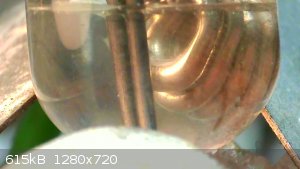
Graphites are well separated, although it's hard to tell in picture.
Apply current and I get.... current limit; 37 [mA].
This solution is very conductive; lots of gas at cathodes *and* on nickel anode.
Allow it to run ... and I'll report back, later.
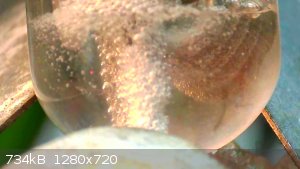
-----------------------------
Note: In my experience, thiourea (found in Broccoli!), is less reactive than urea.
I won't bother running the full experiment, but I'll melt a tube and see if it's even a eutectic or not.
Supposedly, it is:
https://pubmed.ncbi.nlm.nih.gov/24528755/
Choline chloride 136 [g/mol]
Thiourea 76.12 [g/mol]
A 1:2 mix, then has 0.89 the mass ratio. .5g CholineCl, .561g Thiourea.
Result: I get a paste, not a liquid. I'll let it set for a couple of days, just to see; but I don't expect any changes.
----------------------------------------
Back to the test at hand ... it's now 2 hours into operation.
The current limiting circuit is still pegged. It's conductive enough to go above 40mA, but my supply limits it to prevent over-heating and excessive
currents.
As you can see on this shot, the low current electrode has nearly stopped releasing hydrogen. The high current electrode is foaming. The bubbles are
penetrating/foaming into the kerosene region above, which indicates that the ionic liquid's viscosity is increasing. I'm posting an early shot,
because this went caramel color within an hour, and it's dark carmel now; I think by 12 hours, it will be opaque and difficult to see.
No clear evidence of plating on the low current electrode, yet.
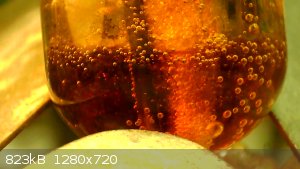
Edit: It has now been 24 hours.
The solution is completely opaque and black. Removal of electrodes does not show any silvery deposit; eg: no evidence of electroplating.
The solution is still liquid, although more viscous than at first; and more conductive.
The higher viscosity is annoying, though, because it causes the foam to float up in the kerosene.
What to do next?
Obvious idea:
The voltage being applied is too high, and decomposing the urea. Possibly lowering (clamping) the voltage might stop the color change and allow an
extended run. (What voltage, though, and why?)
In the previous carboxylic experiment, the low current electrode remained tarnished while the high current electrode showed reduction. Just
'lowering' the current, then, could miss a properly working reaction. The low current cathode has shown no plating, already.
Mix up another tube, yes/no ?

[Edited on 29-11-2023 by semiconductive]
|
|
|
semiconductive
Hazard to Others
  
Posts: 287
Registered: 12-2-2017
Location: Scappoose Oregon, USA.
Member Is Offline
Mood: Explorative
|
|
Last night, when I saw the carmel color in the choline, I suspected the tube was going to go totally black (which it did);
I turned my attention to the other experiment I was already running, the carboxylic acid + ester + lithium carbonate:
I put new cathodes in and cleaned the nickel anode.
Immediately the current rose from 5.5 [mA] up to 12 [mA].
This is fairly typical in many of the experiments I've run in the past.
I decided to lower the amperage to verify that any lower current will not plate. I reduced the current limiter to 3 mA. (This also reduces whatever
voltage is at the anode to make 3mA).
Then let the experiment continue to run, overnight, on a fresh pair of cathodes.
Here's the result:
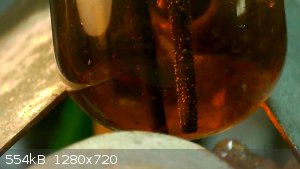
At 5mA, the right cathode will coat with nickel (badly, but it does it.)
But: In this continuation (of the same solution), you can see the bright plating has stopped.
There is a film of some kind on the right (higher current) electrode. But it's dark.
|
|
|
semiconductive
Hazard to Others
  
Posts: 287
Registered: 12-2-2017
Location: Scappoose Oregon, USA.
Member Is Offline
Mood: Explorative
|
|
Experiment #492, start.
7 drops acetic acid, 21 drops ester with multiple oxygen count, sea-salt (NaCl) recrystallized with a tiny amount of NaCO3. (<1%).
The purpose of this experiment is to see if table salt will dissolve in acetic acid + an extra oxygen containing ester. eg: I'm replacing the SO2
bearing molecule with an ester, to see if the presence of extra oxygen might bias the gas release toward the anode.
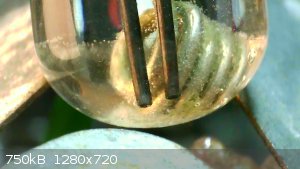
The initial current was 100 [uA]. So, I heated the tube with the soldering iron, and watched the acetic acid attack the bicarbonate in the salt;
resulting in the salt crystal slumping to the bottom of the tube. This ought to expose a lot of surface area to the liquid. Current rose to 3 [mA].
Therefore, this is an ion limited solution.
Bubbles do indeed show up on the anode, heavily. Only a very few gas bubbles on the cathodes; Both the high and low current cathode are slowly
changing color with a whitish film developing on them.
This (mildly) supports the hypothesis that the presence of oxygen or sulfer. can act as a catalyst causing hydrogen loss to preferentially happen
near/at the anode rather than the cathode.
I still can't rule out Kolbe reaction.
Note: 4 hours in current dropped to zero. Bubbles still happened on nickel electrode. I re-heated experiment, and bubbles switched totally from
nickel anode to cathodes with current rising to 8 [mA]. Salt does not appear to have dissolved, appreciably.
I decided to redo the experiment: Fresh nickel electrode, cleaned cathodes and dried them, all chemicals the same. The only difference is I did not
pre-tarnish the nickel in formic acid.
Result: Current again starts at 3 [mA] after heating; BUT -- Sigh...
No bubbles on the nickel, only a few bubbles on the high current graphite cathode.
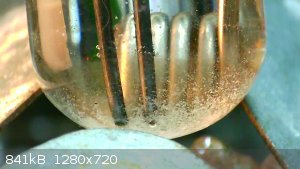
Experiment did not repeat. Will have to retest ... again.  Doh! Doh!
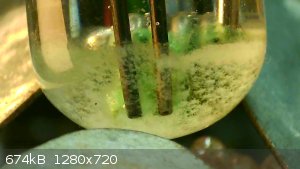
Experiment maintained 2 [mA] all night. Lots of precipitate this morning.
There is obvious white film on high current electrode, less film on low current (left) electrode. The film appears only on the side of the electrode
nearest glass. This is not likely nickel metal.
No appreciable NaCl dissolved into solution.
The color green only appears on the Nickel anode. For some reason (either salt or ester) the solubility of Nickel Acetate is severely reduced in this
experiment.
Will re-run it with no salt to see what happens on fresh nickel anode.
Edit:
7 drops glacial acetic, 21 drops ester, capped with kerosene as usual.
The attempt without salt fails. There is no conductivity even after heating. Total fail.
This means an ester with distributed oxygens does not have the same effect as a sulfer dioxide bearing molecule with concentrated oxygens. SO2 is
able to cause conductivity in acetic acid and bubbles at anode, only. The original experiment #492 was possibly contaminated/anomalous. I'm not
sure what was going on there. Best just to ignore it.
Will try an alternate salt.
Experiment #492 salt variation: Sodium Nitrite.
Immediately salt out-gasses, even before electrodes added to tube.
Conductivity is very low. (100 [uA] or less).
Heating raises conductivity to 2.7 [mA]. (Pretty typical.)
Everything Anode, Cathodes, and glass tube, continue to bubble slightly.
Color is changing rapidly:
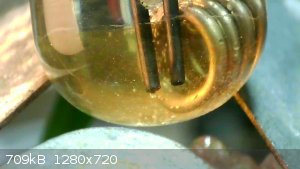
Current dropped back down as liquid cooled. I added more nitrite salt and heated in order bring current back up. Current drops again as cooled.
Added yet more salt ... and this time brown gas started forming in the test tube. I think I've just found another way to break Sodium Nitrate down
into nitrous oxide. Experiment terminated.
Hmmm...
Will try again with potassium nitrate, to see if it reacts with the ester... then add glacial acetic acid.
Experiment #492, potassium nitrate variation.
7 drops glacial acetic, 21 drops ester, capped with kerosene as usual.
2 prill's worth ~20uL/AKA 1 drop volume worth of potassium nitrate salt.
Mixed ester and KNO3, first, heated gently until painful to the touch several times; at max heat a little gas evolves from salt, but I think that may
just be boiling. There is no decomposition of the salt.
Added acetate, shook, heated, capped with kerosene.
It is conductive, but not even 3mA when hot. ~2 [mA]
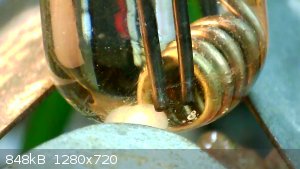
In photo, clearly there is gas evolution at (+) anode.
Nothing on cathodes. Nothing from salt.
Whether this is Kolbe reaction, Acetic attacking the nickel (hopefully), or nitrate being decomposed; I don't know. I will let it run.
--- bubbles slowly but continually on nickel; conductivity has constantly risen 4 [mA ] now, at 19C. Originally solution began to color yellow, then
greenish, but then suddenly formed colloid which is lighter green than the dissolved color.
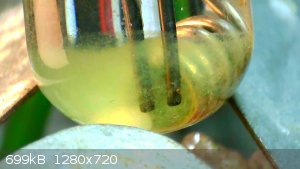
No sign of plating, yet. I'll let it run a couple of days; probably centerfuge it, and see what the equilibrium chemistry is like. Might be an
experiment worth studying to figure out the balance between colloid start and dissolved ions (in the future, not now.)
[Edited on 30-11-2023 by semiconductive]
|
|
|
| Pages:
1
2 |
|